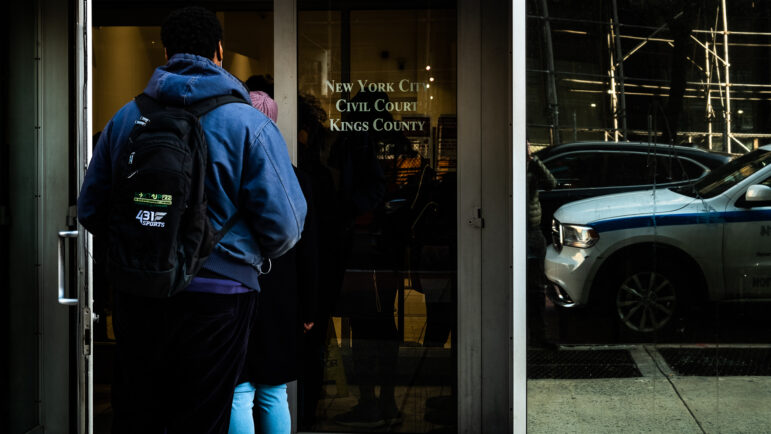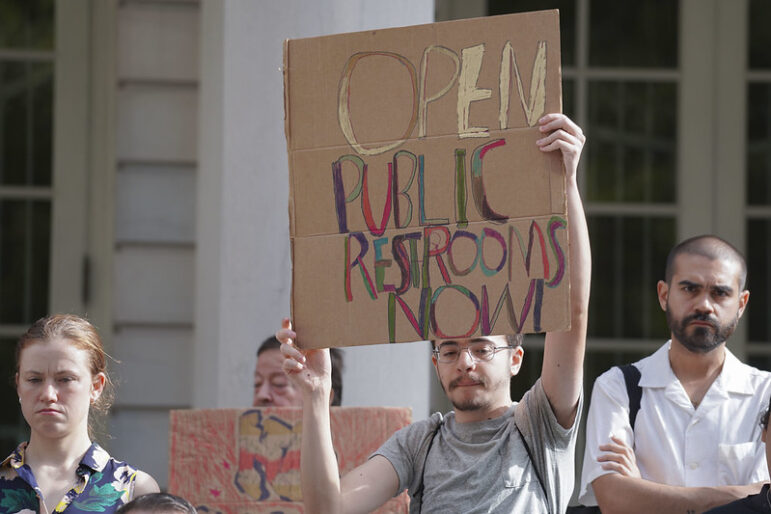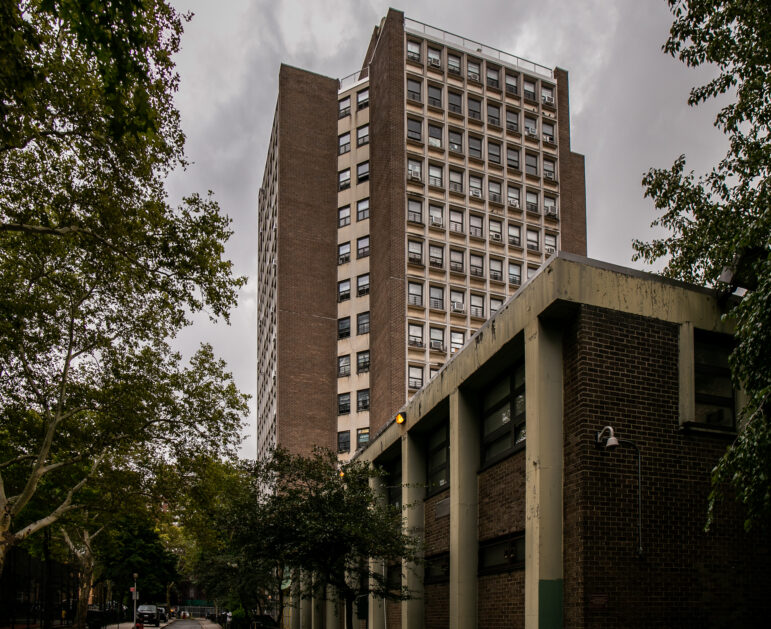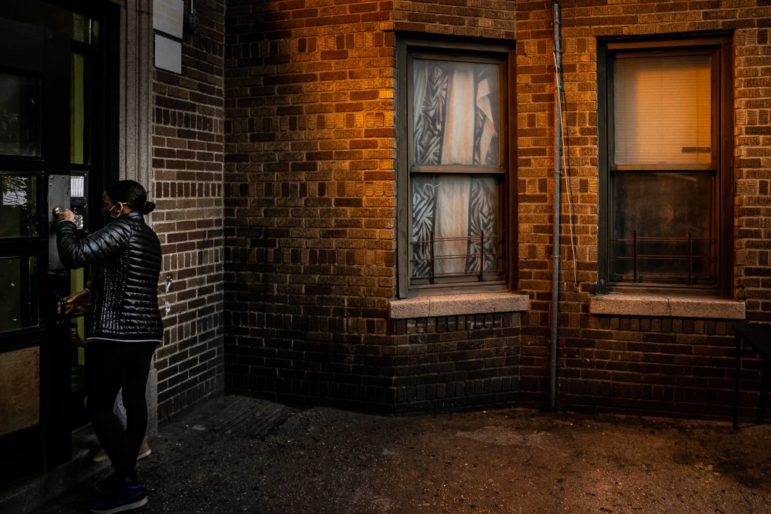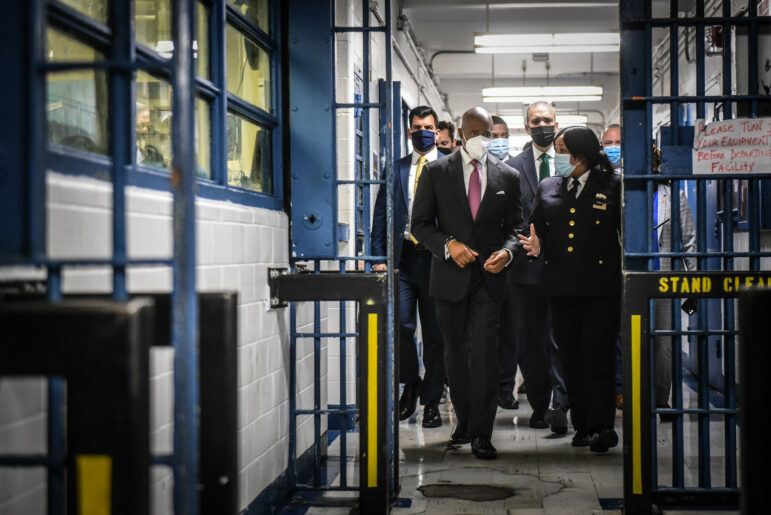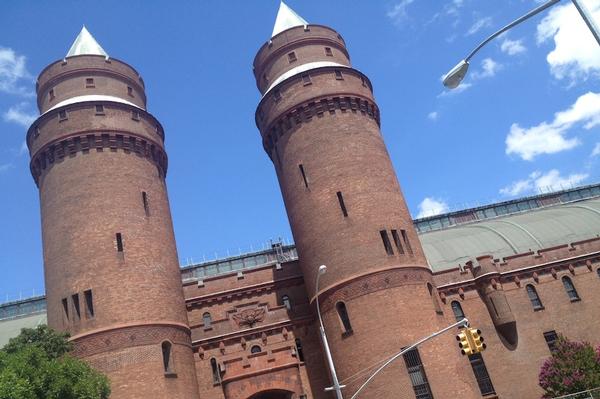
Photo by: Jordan Moss
A plan to build the world’s largest ice sports in the Kingsbridge Armory has the support of developers, the city and a coalition of community groups. If the plan is approved, it will end a two-decade-long saga of competing plans and tension between local community groups and the city.
Almost a century ago, in 1917, the Kingsbridge Armory opened for the National Guard. But the longest battle related to the landmark was launched in 1993 when the soldiers left the building as the state handed it over to the city.
Twenty years later, peace is at hand. A proposal to turn the 575,000-square-foot landmark, on Kingsbridge Road in the northwest Bronx, into a widely unexpected athletic ice-skating center is just at the beginning of a six-month approval process, but it’s widely expected to get the go-ahead. But already, the Armory saga offers a critical policy lesson for ordinary New Yorkers and grassroots organizations working to achieve the greatest degree of community influence on significant projects using public property.
Over the past 20 years, the Armory has been the subject of proposals by school superintendents, who sought to relieve overcrowding, and neighborhood organizations, who wanted school space and community facilities—all shot down by the city. Mayor Giuliani proposed a sports and retail complex. That flopped. Mayor Bloomberg backed a mall, but that proposal failed amid a dispute with a community alliance over whether tenants would pay a living wage to their workers.
Almost four years after the Bloomberg proposal’s defeat, it now looks like an ice center boasting nine athletic skating rinks – the largest such facility in the world – is headed for approval, thanks to support from the community alliance (called KARA, or the Kingsbridge Armory Redevelopment Alliance) the borough president, mayor and councilmembers. There appears to be zero organized opposition.
The Kingsbridge National Ice Center would be the first permanent ice skating facility in the Bronx, a borough with thousands of immigrant families who’ve never skated in their lives. Some might scratch their heads wondering why the plan is considered a win by so many activists and community leaders.
The reason, supporters say, is the Community Benefits Agreement the leaders of KNIC, KARA and other Bronx organizations signed. Its strength is unprecedented in New York City, according to experts. And it could be the model for other projects.
A 20-year saga
National military cutbacks and the structure’s growing deterioration caused the state to vacate the Armory in 1993 and hand it over to the city.
Between 1993 and 1996, two consecutive school superintendents had forums and armory tours with the public, hoping there was a shot at creating schools within the massive facility in a desperately overcrowded District 10, the second worst in the city.
And while that didn’t go anywhere, in 1998 leaders of the Northwest Bronx Community and Clergy Coalition got to work, laying out their ideas with the help of the Pratt Center for Community Development. That led to an ambitious proposal for a project including three 800-seat schools, a sports complex, an exterior park and green market, restaurants, a bookstore and a community center. Despite years of meetings and rallies, that plan was essentially put aside. The city ruled out schools in the inner part of the building, claiming problems with lighting that community advocates were certain could be remedied if the Giuliani administration had committed to the idea.
In January 2000, Giuliani picked RD Management and its partner, Basketball City, to replicate at the Armory their large sports facility in Manhattan. In addition to sports, the companies proposed setting it up a mall that included a movie theatre. But they never came through with a completed plan to push through the approval process. Officials like Adolfo Carrion, Jr., then a councilman, said the developer balked at a high redevelopment expense they didn’t expect. Unlike Bloomberg, Giuliani never even issued an RFP (request for proposals).
For almost five years after Bloomberg came into office in 2002, there were meetings, discussions and tours by officials that led to nothing. Many focused on where to relocate the National Guard, even though they were in separate buildings behind the Armory. So it wasn’t until the fall of 2006 that the city’s Economic Development Corporation released an RFP.
It took three years for the city to choose Related Companies’ proposal for a giant shopping mall, much like its controversial re-do of Bronx Terminal Market. But KARA, with strong support from the Retail, Wholesale and Department Store Union (RWDSU) and Borough President Ruben Diaz, Jr., decided to vigorously oppose the plan unless Related guaranteed that everyone who worked in the Armory mall when it was done got a guaranteed minimum salary — $10 an hour with health insurance or $11.50 without. They argued that Related was receiving about $50 million in city and state tax breaks and paying a miniscule purchase price of $5 million (just replacing the roof years earlier cost the city $30 million). RWDSU and local, unionized supermarkets were worried about competition from new shops in the proposed mall that would pay lower wages.
Diaz, Jr., who had just become Bronx borough president, took the political lead on pushing these efforts. “I want to do business in the Bronx,” Diaz said at a big Coalition/KARA gathering in 2009 when Related was pushing its plan. “[But] it is not radical to simply say, a) we should protect surrounding businesses and b) we should have jobs and livings wages.” He added, “You want to do business, we can do business. But business has to be good for everybody.”
In his consistent mantra on this issue, he added: “If you want to create a mall on your own dime, [then go ahead and pay what you want]. If you want a subsidy, then the community deserves a subsidy as well.”
Councilman G. Oliver Koppell (D-Riverdale, Kingsbridge, Norwood, Woodlawn, Wakefield)—whose district borders the armory—was flexible on the specifics, but unwilling to let a mall go through with significant public funding but no benefit to workers.
“If Related had living wage jobs, we would have gone through with it,” he said.
Related, a large corporation — with mall projects throughout the city and country — wasn’t new to including the living wage (they do just that in Los Angeles where it’s required) but Bloomberg clearly didn’t want to set a Big Apple precedent.
“From early in the planning process, we made clear we would never add mandatory wage requirements which would make the project unviable, and that was a line we were never going to cross,” he said in a 2009 statement. “It’s not the role of the public sector.”
In a rare defeat of a project reaching the end of the public process (it had achieved Community Board 7 approval) the Council voted the ULURP down 45 to 1 in December 2009.
Ice comes to the Bronx
After the Council defeat, the Bloomberg administration did little on the Armory. Diaz commissioned a large study of options for the building; it was criticized for reflecting hope more than realism.
But the mayor and city’s Economic Development Corporation (EDC) did finally put the armory back on the policy play list in early 2012, launching another request for proposals.
Early on, the city announced it was considering two finalists, the Kingsbridge National Ice Center, which proposed the world’s largest ice facility, and a flexible market, planned by Youngwoo and Associates, with entertainment, recreation and business incubator space.
EDC took its time – 14 months after the proposal was launched in early 2012 —to announce they were going with the Ice Center, which, if approved by the City Council, will be the world’s largest with nine rinks.
KARA didn’t get to decide what the Kingsbridge Armory would become. They weren’t invited to promote a vision at the beginning of the process but they met with both Youngwoo and the Ice Center before EDC made a decision. “Ultimately [KNIC] offered a CBA so we started working with them [more closely] to make sure that was going to happen,” says Elisabeth Ortega, an active KARA negotiator, who got involved with the Coalition eight years ago as a youth leader.
Kevin Parker, KNIC’s CEO, discussed the impact of KARA’s efforts at a June press conference in front of the armory.
“If the community wouldn’t want us here, then we wouldn’t come,” he said.
CBAs raise questions
Several New York City projects—Yankee Stadium, Columbia’s West Harlem project, Atlantic Yards, and others—have included CBAs but advocates have often detected a key flaw: the lack of a robust enforcement mechanism if the developer goes back on his or her promises.
In early 2006, many Bronx elected officials hailed the CBA attached to another deal with the Related Companies—turning the Bronx Terminal Market into a mall—as unprecedented. Related signed off on investing $3 million in job training and other programs and reserve space for local and minority-owned businesses. “This agreement should serve as the benchmark for doing business in our borough and throughout the city,” said then-borough president Carrion in his state of the borough address.
But most of the 18 groups that participated in the process said they were not invited to play any role in the final decision. And groups criticized the fact that Related would only have to pay a fine of $60,000 if they didn’t do what they promised and that their employment promises only affected their own hires, not those that would occupy the Bronx Terminal Market over the long term.
The supporters of, and experts on, strong CBAs say agreements led by politicians are simply not CBAs, since elected officials get to vote up and down on the agreement and their decisions may be determined by issues other than the development project at hand.
The KNIC CBA promises to be different. Brokered by community groups, its admirers say it includes a remarkably broad array of benefits—and a tough enforcement clause.
A broad set of benefits
If approved by the City Council, the Armory will have nine ice rinks including one that can seat 5,000 people “and be used to host national and international ice hockey tournaments, figure and speed skating competitions and ice shows,” according to EDC. KNIC also promises that its investment of $275 million will create 890 construction jobs and 267 permanent positions.
In addition to living-wage salaries, KNIC has agreed to a variety of detailed community support: a focus on local hiring and contracting; construction of 52,000 square feet of community space; developing a small-business incubator; $1 million of community in-kind services including giving northwest Bronx residents a discounted rate and priority access to the ice-skating facility; free or discounted tickets for seniors, students and low-income families.
There’s also an agreement for a remarkable 27 “greening” efforts for the project including providing healthy working conditions for employees and contractors; discouraging the sale of sugary drinks, high-fat and highly processed food; collaboration to promote asthma awareness; and ensuring that 20 percent of the project’s space stays undeveloped and is accessible to the public.
NWBCCC and KARA have provided only a summary of the formal CBA (a more substantial, but unofficial “Execution Draft,” is here‘) until a press conference later this summer—making it impossible for Bronx Bureau to confirm that the deal includes a strict enforcement mechanism.
But those directly involved with the negotiations cite their success with certainty.
“We think it’s a landmark agreement and it’s an amazing victory for people in the northwest Bronx,” says Harvey Epstein, a project director of the Community Development Project at the Urban Justice Center, who cited the CBA as “a legally enforceable contract.” If necessary, you “go to court to enforce it. It’s like any contract. You don’t pay me back, I go to court.”
Julian Gross, a San Francisco-based attorney who works closely with Partnership for Working Families on community benefit issues, agrees.
“What makes it a strongly enforceable CBA is that it is legally enforceable by a broad range of independent community organizations and they had a good legal counsel while they were drafting it,” he says. “And it resulted from an inclusive community driven process. [These are the] three things that make it a strong CBA.”
‘Organizing works’
Ronn Jordan, 48, got involved in the Coalition’s armory efforts from the very beginning. He joined up with the grassroots group when, thanks to severe overcrowding, his kindergartner got bused from PS 56, the small public school a couple of blocks from his apartment in Norwood, to the most southern part of District 10.
In June, Jordan proudly came up to the KNIC announcement from Daughters of Jacob, a Mt. Eden nursing home where he now lives. He wouldn’t have come if he wasn’t proud of where things are finally headed, but he’s still keeping his eyes on what put him to work in the first place.
One CBA section addresses this concern directly. KNIC has vowed to seek approval to de-map the area behind the Armory on East 195th Street, still occupied by the National Guard, to provide school space. They’ve also promised to spend up to $100,000 to achieve that.
“We pulled a lot more stakeholders into this and the final result,” Jordan says. “Whether the ice center makes it or not, the end result is: organizing works. If you never take no for an answer, sooner or later the answer becomes yes.”
In 1993, when the Guard vacated, Koppell highlighted a potential model for the Armory: Lake Placid’s ice skating facility with four rinks. He doesn’t claim that something he stressed a couple of decades ago, without much support, is relevant to what’s happening now. But he believes vigorous opposition to city policies teaches mayors, and all city officials, a key lesson — that the community’s efforts should be relevant in all such significant projects.
“The key thing is to work actively with the community and try and meet the legitimate demands of the community when you’re putting together a project,” Koppell says, adding, “You can’t always accommodate every community need but you should try, and not try and push something through just because it’s feasible.”
Gross, the attorney from Los Angeles, says that as strong as the Armory CBA is, it’s critical that community groups stay engaged. “I’m optimistic that groups in this CBA can monitor access but I would also like to see broader community involvement in CBA implementation,” he says. “It should be a shared task.”
Lessons learned
To get things to this point, it took 15 years of the Coalition’s devoted activism and nine years for all the groups under KARA. That raises the question of whether the vast time and effort on behalf of so many community residents and paid organizers, was worth it.
“If the impact of this project was just limited to one community, then I would have a serious question about the utility of a fight that was that long,” says Mary Dailey, who was the Coalition’s executive director from 1994 to 2005. But, thanks to the persistence of the organizers, they were able to achieve an unprecedented fusion economic justice and environmental sustainability into the final CBA deal. “That can have a positive impact on projects beyond the scope of this individual project [and] around the country,” Dailey says.
For all the excitement over KARA’s achievement, CBA experts wish residents could play even more of a key role—as the Coalition pushed for early on—in determining what was going inside the massive landmark.
“There should have been more representation before the [city’s] RFP [Request for Proposal] goes out,” says Good Jobs New York project director Bettina Damiani, who has shared her expertise with the Coalition. “We’re still at a place in New York City where major development decisions are made without the communities at the table. The community is still left to react to a proposal that is designed by officials. What KARA managed to do was really insert itself as strongly as I’ve seen in that process.”
Joan Byron, the director of Policy for the Pratt Center for Community Development who worked with the Coalition for many years after their push began, hopes Giuliani’s failure, and Bloomberg’s still-pending, but likely, success has an impact on how the next mayor handles similar planning.
“‘We’re still going to have stuff to build,'” she envisions him or her announcing, “‘but we’re going to ensure that it has benefits for the community.'”


